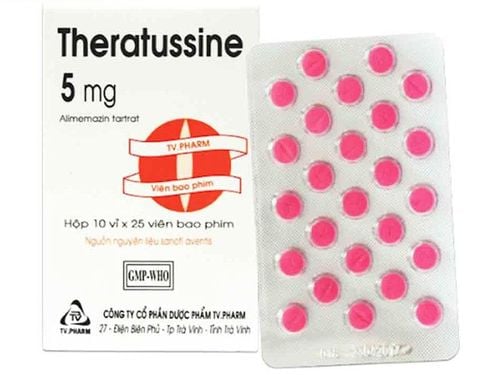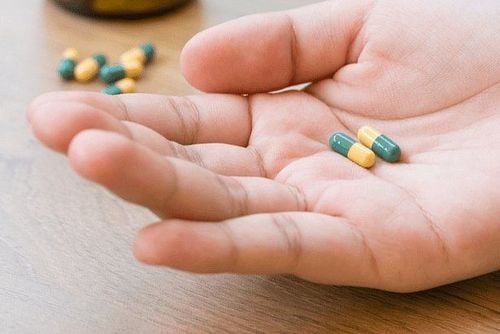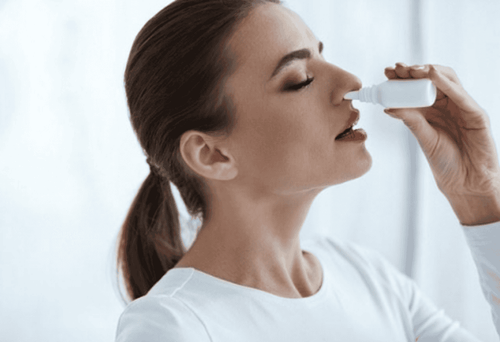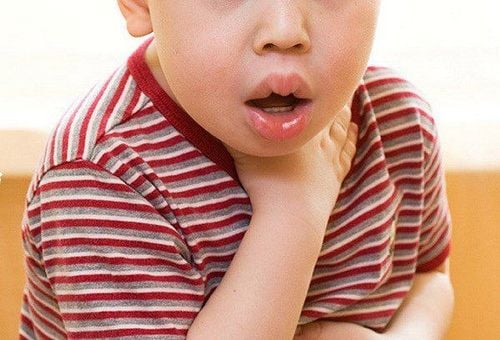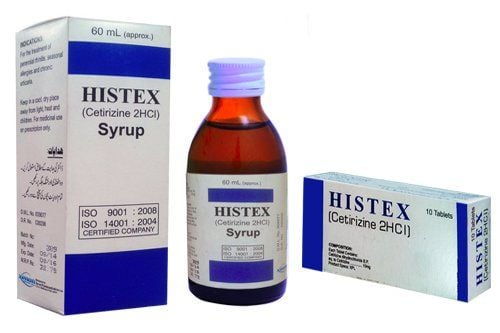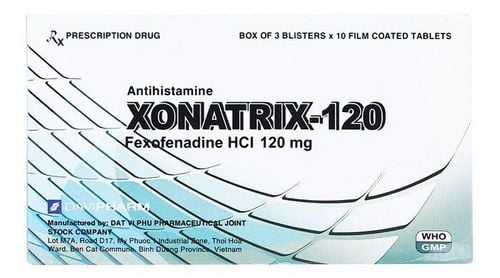This is an automatically translated article.
Alimemazine is an antihistamine that works to treat allergic symptoms (allergic rhinitis, cough, sneezing, runny nose; skin allergies such as urticaria, rash). In addition, the drug is also used in cases of sudden or transient insomnia (due to preparing to go away or having emotional events...)1. Alimemazine drug information
Name of active ingredient: Alimemazine Brand name: Acezin DHG 5, Thémaxtene, Alimemazine 10, Alimemazine 5,... Drug class: Antiallergic drug Drug form: Tablets, capsules, syrup, film-coated tablets.
2. Uses of Aginmezin 10
Alimemazine is a phenothiazine derivative, has strong anti-histamine and anti-serotonin effects, the drug also has sedative, cough-reducing, anti-emetic effects. Alimemazine competes with histamine at the H1-histamine receptors, thereby having an H1-antihistamine effect. It antagonizes most of the pharmacological effects of histamine, including urticaria and pruritus. The peripheral anticholinergic effect of the drug is relatively weak, but has been observed in some patients who have received alimemazine (eg, dry mouth, blurred vision, urinary retention, constipation). Alimemazine has a sedative effect by inhibiting the enzyme histamine N - methyltransferase and by blocking central histamine-secreting receptors concurrently with effects on other receptors, especially serotoninergic receptors. This effect is also the basis for using alimemazine as a pre-anesthetic. Alimemazine has an antiemetic effect. The mechanisms of this effect are not completely known. The antiemetic effect may be due to a direct effect of the drug on the chemosensitive center of the spinal cord, presumably by blocking dopaminergic receptors in this region.
3. Indications for taking Aginmezin
Acute state of delirium (due to alcohol withdrawal). Preoperative anesthesia. Respiratory (rhinitis, sneezing, runny nose) and skin (urticaria, pruritus) allergies. Vomiting frequently in children. Insomnia of children and adults.
4. Dosage - how to take Aginmezin
Do not use for children under 2 years old. Cure urticaria, itchy papules:
Adults: 10mg, 2 or 3 times a day, even up to 100mg a day in refractory cases. Elderly people should reduce the dose by 10mg, 1-2 times a day. Children > 2 years old: 2.5 - 5mg, 3-4 times a day. Use before anesthesia:
Adults inject 25-50mg (1-2 syringes), 1-2 hours before surgery. Children 2-7 years old: Take the highest dose is 2mg/kg body weight, 1-2 hours before anesthesia. Use with anti-histamine, anti-cough effect:
Adults take 5-40mg/day, divided into several times. Children drink: 0.5 -1mg/kg body weight/day, divided into several times. Used to induce sleep:
Adults: 5 - 20mg, taken before going to bed. Children: 0.25 - 0.5mg/kg body weight/day, taken before going to bed. Used to treat acute alcohol delirium (agitation):
Adults orally or by injection (intravenous or intramuscular) 50-200mg/day.
5. Contraindications
Do not use for people with liver or kidney dysfunction, epilepsy, parkinson's disease, hypothyroidism, pheochromocytoma, myasthenia gravis, prostate enlargement. Do not use in people who are sensitive to phenothiazines or have a history of narrow-angle glaucoma. Do not use in cases of overdose due to barbituric, opiate and alcohol. Do not use when leukopenia, when there is a previous episode of agranulocytosis. Do not use for children under 2 years old.
6. Drug interactions
The CNS depressant effect of this drug is enhanced by: alcohol, barbiturates and other sedatives. Respiratory depression has also occurred with the combination of these drugs. Increases the effect of antihypertensive drugs. The anticholinergic effect of Alimemazine is increased when combined with other anticholinergic drugs leading to constipation, seasickness. Alimemazine antagonizes the therapeutic effects of Amphetamine, Levodopa, Clonidine, Guanethidine, Adrenalin. Some drugs that inhibit the absorption of Alimemazine are antacids, Parkinson's drugs, lithium
7. Side effects of the drug Aginmezin
Frequency of undesirable effects depends on dose and duration of use, and indications for treatment:
Common: Fatigue, drowsiness, headache, dizziness.
Mild: Dry mouth, thick phlegm.
Uncommon: Constipation, urinary retention. eye accommodation disorder.
Rare:
Blood: Agranulocytosis, leukopenia. Circulation: Lowers blood pressure, increases heart rate. Liver: Jaundice hepatitis due to cholestasis. Neurological: Extrapyramidal symptoms, parkinsonian tremor, restlessness, acute dystonia, tardive dyskinesia. Dry mouth can damage teeth and enamel, phenothiazines can lower the seizure threshold in epilepsy. Respiratory: Risk of respiratory arrest, even sudden death, has been observed in young children. Instructions for management:
Extrapyramidal reactions:
Extrapyramidal reactions caused by phenothiazines are generally divided into 3 main categories: Reactions that cause increased muscle tone, sensation of being constantly on the move (i.e., palpitations). lying, restless) and parkinsonian symptoms and signs.
Most patients with dystonia respond rapidly to treatment with anticholinergic antiparkinsonian drugs (eg, benzotropin, trihexiphenidyl) or with diphehydramine.
Signs and symptoms of restlessness usually go away on their own. However, if the condition is bothersome, it can often be controlled by reducing the dose or by concomitant administration of an anticholinergic antiparkinsonian, a benzodiazepam or propranolol.
Parkinsonian symptoms: usually controlled using a combination of anti-parkinsonian anticholinergic drugs. However, anti-parkinsonian drugs are only used when absolutely necessary.
Malignant syndrome: Due to sedation can occur in patients taking phenothiazine derivatives or other psychoactive drugs. This syndrome is characterized by hyperthermia, severe extrapyramidal disturbances (including increased skeletal muscle tone), varying degrees of loss of consciousness (including lethargy and coma) altered mental status. changes (including hypotonic reactions) and autonomic instability (including cardiovascular effects).
Treatment of malignant neuroleptic syndrome requires immediate discontinuation of phenothiazines, symptomatic and supportive treatment, treatment of water and electrolyte balance, keeping the patient cool and maintaining renal function, correction of disturbances cardiovascular disorders (stabilize blood pressure), prevent respiratory complications. Currently, there is no cure for this syndrome.
8. Note when using
Caution when used for the elderly, especially when it is too hot or too cold (causes orthostatic hypotension, dizziness, drowsiness, constipation). Alimemazine may interfere with skin tests for allergens, avoid alcohol or CNS depressants. Use with caution in patients with cardiovascular disease.
9. Pharmacodynamics
Pharmacodynamics:
Alimemazine is an H1 receptor antagonist, a sedative.
Pharmacokinetics:
Alilmemazine is rapidly absorbed from the gastrointestinal tract. After taking 15-20 minutes, the drug takes effect and lasts 6-8 hours. The plasma half-life is 3.5 – 4 hours; The binding to plasma proteins is 20-30%. Alimemazine is excreted by the kidneys as sulfoxide metabolites (70-80%, after 48 hours).
Please dial HOTLINE for more information or register for an appointment HERE. Download MyVinmec app to make appointments faster and to manage your bookings easily.




